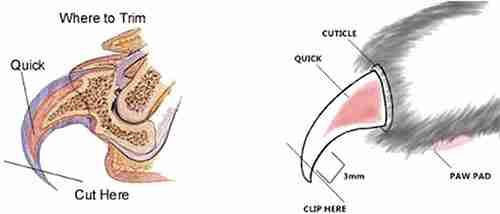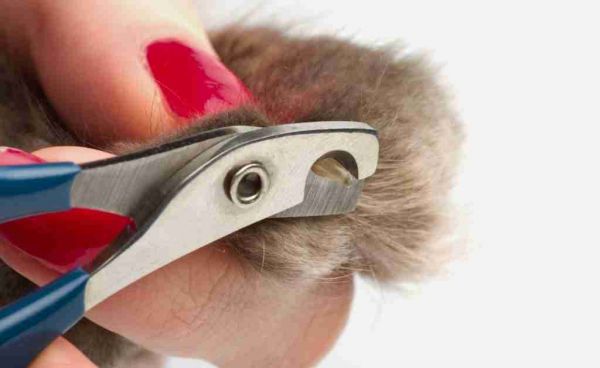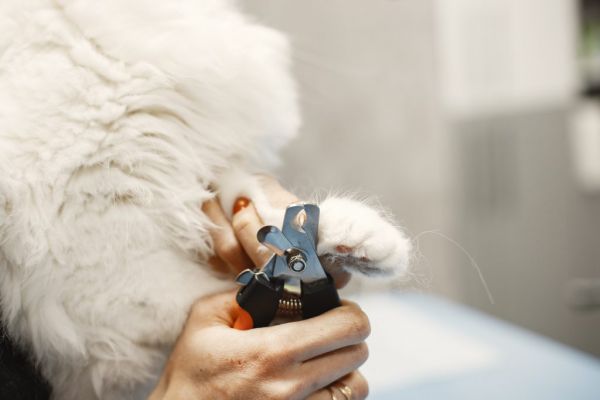A Vet’s Guide To Keeping Your Cat's Nails Healthy
Are your cat’s claws causing you concern? Fear not, for this vet’s guide is here to help you keep your cat’s nails in tip-top shape. Discover the importance of cat claw health and how their natural behavior plays a role.
Learn how to address common issues and when to consult a vet. Safely trim your cat’s claws with confidence, and find out how to prevent overgrowth in older cats.
Plus, uncover the role of scratching posts and the power of rewards in a positive claw care experience.
Key Takeaways
Cat claws are retractable and irregularly replaced, so most young and adult cats do not need to have their claws trimmed.Providing suitable scratching options encourages cats to keep their claws in good condition and helps them remove the old part of the nail.Cats use scratch posters to transfer their scent and enjoy having their own familiar scent in the home.Consulting a vet is important if unsure about the need to trim claws, if a nail has grown into the pad, or if the cat is older or less active.Understanding the Importance of Cat Claw Health
Understanding the importance of cat claw health is crucial for keeping your cat happy and comfortable. Cat claws serve multiple purposes, such as scratching to remove the old part of the nail and marking territory with their scent. Most cats do not require regular claw trimming, but it is essential to provide them with suitable scratching options to keep their claws in good condition.
Older cats may experience issues like overgrown and thickened nails, difficulty retracting claws, or discomfort due to arthritis. Consulting a vet is recommended if you are unsure about the need to trim your cat’s claws or if you notice any nail-related issues.
When trimming claws, make sure to use appropriate clippers and be cautious not to cut them too short, causing bleeding and pain. Afterward, reward your cat with their favorite game, special treats, or gentle strokes if they enjoy it.
The Cat Claw Cycle
 Credit: East Port Vet
Credit: East Port VetTo keep your cat’s claws healthy, it’s important to understand their natural behavior and how they use them. Cat claws are retractable and irregularly replaced, and scratching wood or soft surfaces helps remove the old part of the nail.
Most young and adult cats don’t need their claws trimmed, but outdoor cats use them for climbing. Providing suitable scratching options encourages cats to keep their claws in good condition. Cats also use scratch posts to transfer their scent and enjoy having their own familiar scent in the home.
Older cats may have overgrown and thickened nails, while less active cats may struggle to retract their claws. If you’re unsure about the need to trim claws, consult a vet. And when it comes to trimming, close windows and doors, use a towel or blanket, hold the cat securely, and have another person assist if possible.
Common Issues With Cat Claws and How to Address Them

If your cat’s nails are overgrown or causing discomfort, it’s important to consult a veterinarian for proper care and guidance. Here are some common issues with cat claws and how to address them:
Ingrown nails: If a nail has grown into the pad, seek vet advice. Trimming the nail properly can prevent further pain and infection.
Thickened nails: Older cats may suffer from thickened nails, which can make scratching uncomfortable. Regularly check the nails and consult a vet if necessary.
Difficulty retracting claws: Less active cats may have difficulty retracting their claws. Providing suitable scratching options and encouraging exercise can help keep the claws in good condition.
Remember to handle your cat’s paws gently and regularly check their nails for any issues.
When to Consult a Vet for Cat Claw Care
When you notice any abnormalities or issues with your cat’s claws, it’s important to consult a veterinarian for proper assessment and advice. They have the knowledge and expertise to determine the best course of action for your cat. Here are some situations when it’s necessary to seek veterinary help:
SituationReasonExcessive scratchingCould indicate an underlying medical conditionBleeding or painMay be caused by a broken or ingrown nailAbnormal nail growthCould be a sign of nutritional deficiencies or other health issuesDifficulty retracting clawsCould be due to arthritis or other joint problemsSteps for Safely Trimming Your Cat’s Claws
 Credit: Gustavo FringStart by making sure that all windows and doors are closed to prevent your cat from escaping while you safely trim their claws.Begin by placing a towel or blanket on a hard surface to provide stability for your cat.Hold your cat securely and remain calm throughout the process. If possible, have another person assist you.Use appropriate clippers to trim the curved tip of each claw, being careful not to cut too short, as this can cause bleeding and pain. If you are unsure, it is always better to err on the side of caution.After trimming, reward your cat with their favorite game or a special treat.
Credit: Gustavo FringStart by making sure that all windows and doors are closed to prevent your cat from escaping while you safely trim their claws.Begin by placing a towel or blanket on a hard surface to provide stability for your cat.Hold your cat securely and remain calm throughout the process. If possible, have another person assist you.Use appropriate clippers to trim the curved tip of each claw, being careful not to cut too short, as this can cause bleeding and pain. If you are unsure, it is always better to err on the side of caution.After trimming, reward your cat with their favorite game or a special treat.Tips for Aftercare Following Claw Trimming
Remember to be gentle and patient with your cat as you provide aftercare following claw trimming. Your cat may feel a little bit sensitive after having their claws trimmed, so it’s important to create a calm and soothing environment for them. Here are some tips for aftercare:
Aftercare TipsKeep the area where the claw trimming took place clean and free of any debris.Monitor your cat’s claws for any signs of infection or irritation.Offer your cat a comfortable place to rest and relax after the procedure.Provide your cat with plenty of opportunities for exercise and play to help keep their claws healthy and strong.Preventing Nail Overgrowth in Older Cats
To prevent nail overgrowth in older cats, you should regularly check and trim their claws to ensure they remain at a healthy length. Here are some key points to keep in mind:
Understand the natural phenomenon of cat claws: Cat claws are retractable and irregularly replaced. Scratching helps remove the old part of the nail, and outdoor cats use their claws for climbing. Providing suitable scratching options encourages cats to keep their claws in good condition.
Consider scent marking and familiarity: Cats use scratch posters to transfer their scent and enjoy having their own familiar scent in the home. However, older cats may suffer from overgrown and thickened nails, and less active cats may have difficulty retracting claws, especially if they have arthritis.
Consulting a vet is important: If you’re unsure about the need to trim your cat’s claws or if a nail has grown into the pad, it’s best to consult a vet. It’s also beneficial to get cats used to having their paws handled from a young age and regularly check their nails for any issues.
Follow a safe claw trimming process: Close windows and doors to prevent escape, use a towel or blanket under the cat for a hard surface, hold the cat securely, and have another person assist if possible. Use appropriate clippers to trim the curved tip of the claw, taking care not to cut too short to prevent bleeding and pain.
Remember, aftercare is key: Provide a reward for your cat after claw clipping, such as playing their favorite game or giving them a special treat. Stroke them if they enjoy it.
How to Help Cats With Arthritis Maintain Healthy Claws
Make sure you regularly provide suitable scratching options for your cat with arthritis to help them maintain healthy claws.
Cats with arthritis may have difficulty using traditional scratching posts or furniture due to joint pain. Consider providing them with low-impact scratching options, such as horizontal scratching pads or mats, that are easier on their joints.
Additionally, you can try incorporating interactive toys that encourage gentle scratching or provide scratching surfaces at different heights to accommodate their mobility limitations.
The Role of Scratching Posts in Cat Claw Care
When providing scratching options for your cat, make sure they are sturdy and stable to encourage regular use. Cats need to scratch to remove the old part of their nails and keep them in good condition.
Scratching posts are a great way to provide this opportunity for your cat. The posts should be tall enough for your cat to fully stretch and have a textured surface that mimics tree bark. This will attract your cat and make them more likely to use the scratching post instead of your furniture.
Place the posts in areas where your cat spends a lot of time, such as near their favorite sleeping spot or by a window. By providing suitable scratching options, you can help your cat maintain healthy claws and save your furniture from damage.
Rewards and Enrichment for a Positive Claw Care Experience
Ensure you provide a reward for your cat after trimming their claws to create a positive experience.
Aftercare and rewards are important for cats to associate claw trimming with something pleasant. Once you have finished the trimming process, offer your cat a reward such as their favorite game or a special treat. This will help them associate the experience with something positive and may make future claw trims easier.
Additionally, if your cat enjoys being stroked, give them some gentle strokes as a reward. Remember to keep the rewards consistent and use them every time you trim their claws.
Frequently Asked Questions
How Often Should Cat Claws Be Trimmed?
You should trim your cat’s claws as needed to prevent them from becoming too long. Regularly check their nails for any issues and consult a vet if you’re unsure or if a nail has grown into the pad.
Can I Use Human Nail Clippers to Trim My Cat’s Claws?
No, you should not use human nail clippers to trim your cat’s claws. It’s important to use appropriate clippers to prevent injury. Consult a vet for the safest and most effective way to care for your cat’s claws.
What Should I Do if My Cat’s Claw Starts Bleeding During Trimming?
If your cat’s claw starts bleeding during trimming, remain calm and apply gentle pressure with a clean cloth or tissue to stop the bleeding. If it persists or worsens, contact your vet for further assistance.
Are There Any Alternatives to Trimming Cat Claws?
There are alternatives to trimming cat claws, such as providing suitable scratching options to encourage cats to keep their claws in good condition. Consulting a vet can help determine the best approach for your cat’s nail care.
How Can I Prevent My Cat From Scratching Furniture or Other Undesirable Surfaces?
To prevent your cat from scratching furniture or other undesirable surfaces, provide suitable scratching options and discourage them from scratching by using deterrent sprays or sticky tape. Regularly trim their claws to reduce damage.
What is the difference between declawing and trimming?
Declawing is a surgical procedure that involves the removal of a cat’s claws, often at the last joint of each toe. It’s a highly invasive and controversial practice. Trimming, on the other hand, is a routine grooming procedure where a cat’s nails are clipped to prevent them from becoming too long. Trimming does not involve the removal of the claws themselves, only the tips. We do NOT recommend declawing cats. This is both cruel and dangerous.
What can I use instead of clipping my cat’s nails?
Instead of clipping your cat’s nails, you can consider using a cat scratcher or providing appropriate scratching posts to help naturally wear down their nails. Additionally, there are nail caps available, such as Soft Paws, which can be temporarily glued onto your cat’s claws to prevent damage.
Does Petsmart clip cat’s nails?
Yes, many Petsmart locations offer cat nail trimming services as part of their grooming services. It’s advisable to check with your local Petsmart store for specific details and availability, as services may vary by location.
相关知识
Grooming a Cat: A Guide to Bathing, Brushing & Trimming Nails
How to trim your dog's claws
Soothing Chicken Broth Recipe for Cats with Sensitive Stomachs
“猫咪抓伤自疗,改掉坏习惯,宠物更健康。”
Clear Signs That Your Leopard Gecko Is Sick Or Dying
How To Trim Cat Claws
A Comprehensive Guide to Care for a Leopard Gecko
The Ultimate Guide to Caring for Leopard Geckos
Cat Grooming Tips
英语作文:养宠物 Raise a cat(精选23篇)
网址: A Vet’s Guide To Keeping Your Cat's Nails Healthy https://m.mcbbbk.com/newsview1164936.html
| 上一篇: How to Trim a Ca |
下一篇: How to Cut Your |
